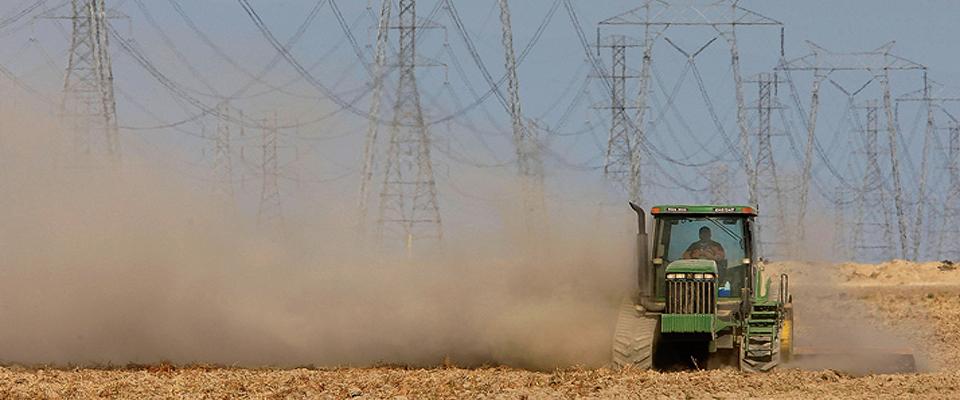Disastrous wildfires are popularly associated with drought. But the North Bay fires followed one of the wettest winters in decades.
The nightly news tends to make things even more confusing. During drought, newscasters sound the alarm about dead trees and the general flammability of parched forests. After wet winters, dire warnings are issued about the abundant growth of grass and brush that will become tinder during the hot, dry days of California’s summer and fall. So are wet winters worse for fires? Or are dry winters worse?
The answer to both questions, says Sally Thompson, a Berkeley associate professor of civil engineering, is yes. Wet or dry, California will burn to one degree or another every year. That’s because, with the exception of the Sierra Nevada, the state has a Mediterranean climate, one characterized by generally mild winters and hot, dry summers and autumns. This encourages “fire-adapted landscapes” that support native trees, shrubs and grasses that are largely inured to fire, or even require it to propagate; so-called “serotinous” plants need fire to release their seeds.
The expansion of residential and commercial developments into wildland areas means that fires that would’ve done nothing more than burn brush and grass 10 or 20 years ago now pose significant risk.
“Regardless of winter precipitation, wildland fuels inevitably are desiccated and ready to burn by late summer and fall,” Thompson says. “The risk is better calculated from a daily rather than an annual perspective—what the humidity is, and what the winds are doing on a particular day. When the North Bay fires ignited, temperatures were high, humidity was very low, and there were exceptionally strong, dry winds.”
That said, Thompson adds, fire risk is increasing in California for two reasons: climate change and the increased growth of “interface” in wildland areas. Climate change clearly is leading to drier, warmer conditions over the long term, translating to longer fire seasons. And the expansion of residential and commercial developments into wildland areas means that fires that would’ve done nothing more than burn brush and grass 10 or 20 years ago now pose significant risk to human lives and valuable homes. This both increases the costs of fire-fighting and imposes increased risks on firefighters. Instead of backing off from an advancing fire and burning out fuels to the approaching flames—the preferred strategy in remote areas—firefighters must now struggle to save individual homes in active burn zones at great personal peril.
Additionally, intense wildfires tend to destroy all vegetation right down to mineral earth, greatly increasing the likelihood of destructive erosion and landslides. That’s certainly the case in the North Bay, where crews are now feverishly involved in “buttoning up” the burn areas by draping slopes and declivities with straw wattles, long, serpentine bundles of straw that catch and hold eroded soils before they can sluice into waterways.
Strategies to reduce wildfire risk are thus essential, but they’ll necessarily vary by region, says Thompson. In the Bay Area, risk reduction might include such avenues as rezoning; development restrictions in specific areas; strictures on planting certain kinds of ornamental trees and shrubs; burying electrical services where practical, and rigorously trimming trees around existing power lines and transformers; immediate and widespread deployment of straw wattles after fires to prevent destructive erosion and dangerous landslides; and perhaps most importantly, maintaining “defensible space,” i.e., removing all flammable vegetation from a 100-foot radius around homes and buildings.
“It’s not a matter of going in once, cutting some trees, and moving on. Management has to be ongoing. You have to return every few years and continue to control vegetation. That’s expensive.”
But different approaches can be taken in unpopulated forested areas, says Thompson. Indeed, some strategies may have a significant ancillary benefit: increasing water transport through wooded drainages, bolstering local springs, creeks and ultimately, reservoirs. At the same time, however, the difficulties of implementing such programs shouldn’t be underestimated, nor should their benefits be overblown.
“Intensive fuels management through prescribed fire and mechanical removal—tree thinning and selective harvest—can reduce wildfire risk,” Thompson says, “but it’s not a matter of going in once, cutting some trees, and moving on. Management has to be ongoing. Trees and chaparral grow back, so you have to return every few years and continue to control vegetation. That’s expensive. It can make sense in specific areas like the Lake Tahoe Basin, but not for all forested areas. Economics comes quickly into play.”
An approach increasingly favored by wildland ecologists is also the easiest to implement. Simply letting wildfires burn, it turns out, may be the best way to establish ecological stability in our wildlands and more or less fireproof entire landscapes. As noted, California, including the Sierra Nevada, is a fire-adapted region, but the Sierra forests of today are not the Sierra forests of a century ago. Though the vast, lush carpets of ponderosa pine and white fir now carpeting the Sierra Nevada appear healthy, they are artificial constructs, created by decades of fire suppression. They form impenetrable “fuel ladders” that are highly susceptible to catastrophic wildfire. Such extreme tree density encourages massive beetle invasions that kill millions of trees, further exacerbating fire risk. Densely stocked forests are also thirsty forests, sucking up mega-gallons of water that would otherwise percolate through aquifers and charge streams and reservoirs.
Experiments conducted by Thompson, Cal professor of environmental science, policy and management, Scott Stephens, and other UC researchers in the Illilouette Creek Basin (ICB) in Yosemite National Park, indicate repeated burn cycles can reboot the Sierra Nevada’s forests. When the basin was subjected to regular low-level fires, uniform stands of densely packed spindly trees were replaced by a rich and variegated landscape of groves of large conifers, shrub lands and meadows. Perhaps most dramatically, soil moisture also increased significantly, yielding dramatic benefits during the recent drought. Tree mortality in the Illilouette Basin was the lowest of all watersheds in the region; some neighboring watersheds had tree mortality that was 52 times greater than that of the ICB. Additionally, the ICB supported numerous wetlands even through the summers of 2014 and 2015, the height of the drought.
One caveat, though. As with active and ongoing thinning and selective harvest, you can’t just burn once and walk away. Fire needs to be introduced regularly into the forest to maintain the desired—that is, the historic—landscape and hydrology. If nature can’t do it, people may have to step in.
While the North Bay fires burned through some state and regional parks, most of the burning occurred on private land, and it’s exceedingly challenging for local governments to impose rigorous ordinances that could hobble building on private property.
“We’ve found that it only takes five to seven years [of forest regeneration] to see the water dynamics return to the old baseline,” Thompson says, “so it’s also not clear that the water benefits are scalable—that you’d get the same results across the landscape scale. Our work does indicate that fire will, over time, return Sierra Nevada landscapes to a more natural and resilient condition. But again, what might work for the Sierra isn’t at all appropriate for areas like the North Bay. We have to tailor our fire risk reduction strategies for specific regions.”
Land ownership also comes into play in determining fire strategies observes David Ackerly, a Cal professor of integrative biology who focuses on the effects of climate change on California biodiversity. Fire policy is pretty easy to draft and implement on national forests, Ackerly says. The U.S. Forest Service has a fairly effective chain of command, and everyone involved is pretty much in accord on the necessity of managing fire. But while the North Bay fires burned through some state and regional parks, most of the burning occurred on private land, and it’s exceedingly challenging for local governments to impose rigorous ordinances that could hobble building on private property. The need for tax revenues and the power and pressure of local business and development interests militate against such actions. Ackerly cites a discussion with an acquaintance who lived through a major Sonoma County fire in the 1970s.
“The proposals we’re now hearing about restricting development in specific high risk areas came up then,” Ackerly says. “But they were ignored then, and it’s likely they’d be ignored now. The pressure to rebuild is so great, and any radical rezoning would be seen as an abrogation of private property rights. But these fires are not random polygons on a map. They tend to occur and reoccur in the same general areas.”
For areas with lots of interface, then, it must be assumed that disastrous fires will repeat, like earthquakes in a seismic zone. Frequency then becomes the critical issue: How much risk is tolerable? Once every five years? Once every fifty years? The North Bay fires skew more to the second degree of probability, but it’s not as though any degree of human effort will be sufficient to avoid the worst possible scenario at some point in time.
“An interesting thing about the North Bay fires is that they were virtually unstoppable in the first eight hours due to this rare combination of extreme low humidity and extreme high winds,” Ackerly says. “After that, they behaved as typical low-intensity mosaic burns—the kind of fires that typify California ecosystems. We’re already seeing a lot of the oaks that were scorched sending out new buds. One thing to look for is whether the intense burns were enough to trigger ecosystem transition. Will all of the oak woodlands come back as oak forest? Or will the fires, in conjunction with climate change, cause some areas to shift to oak savanna, or even grassland?”





















